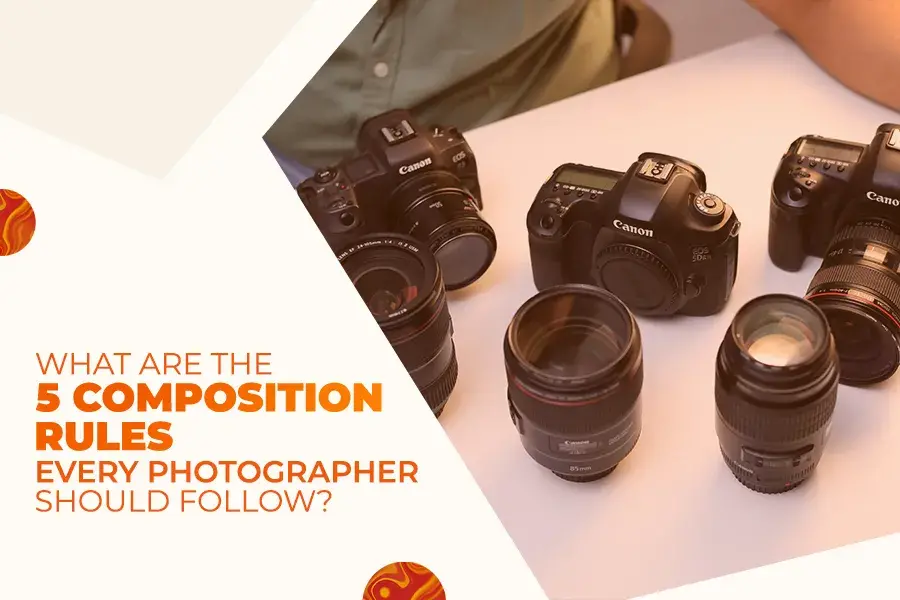What are the 5 Composition Rules Every Photographer Should Follow?

In the product photography career following every rule of photography and composition is essential and crucial, Photography is a career that is all about creativity and imagination, and product photography requires a more detailed mindset to achieve the images that you are visualizing.
Composition is the backbone of captivating product photographs. It’s the art of arranging objects and elements within the frame to create visually appealing and impactful images. Understanding the rules of composition in photography is essential for aspiring photographers to take their craft to the next level.
In this blog, we’ll explore the fundamental composition rules that every photographer should know to create stunning images.
What is a Composition in Photography?
In product photography, composition is simply meant to arrange the visual elements or products within a frame to achieve visual attraction.
To get the perfect product photo shots the photographer tries to follow all the rules of photography and organize elements in a scene to enhance the product photoshoot.
To enhance your product photoshoots to the best and give you the desired results you should keep in mind the product photography composition rules.
5 Composition Rules in Photography That Professionals Use
1. Rule of thirds

The rules of photography and composition start with one of the most basic yet crucial composition techniques in product photography is the rule of thirds.
If you imagine your image divided into a grid of nine equal parts with two horizontal and two vertical lines.
Now the key elements of your photo should be placed and their intersections, which are known as “power points”.
This creates a balance initiating a visual interest and attracting the viewer’s attention to the scene. As a photography rule, the rule of thirds is what can set a learning base for any beginner photographer.
In product photography rule of thirds can be practised by placing the product or the focal point of the image along one of these imaginary lines or at one of the intersection points. This off-center placement adds visual; interest to the image.
To learn more about this composition technique in photography
Join the FDS product photography masterclass to enhance your skills in the field of product photography.
2. Leading Lines

Adding to the composition rules in photography, as the name suggests the leading lines are lines within a photograph that lead the viewer’s attention towards a specific focal point.
These lines can be imaginary and put into anything from roads and pathways to fences and tree branches etc.
In product photography, leading lines can be used to guide the viewer’s attention to the product to highlight its key features.
For example, you can use lines on the packaging or surrounding elements in the frame to direct the viewer’s eye toward the product or the focal point.
By incorporating leading lines into your composition, you can create depth and dimension, guiding the viewer’s gaze and adding visual interest to your images.
3. Symmetry and Patterns

As a photography rule symmetry and patterns are visually compelling and can create amazing compositions.
It can be both natural or man-made elements that incorporate symmetry or repetitive visually striking patterns, such as buildings, bridges, or even flower petals.
In product photography symmetry and patterns can be done by following the basic product photography composition rules, centring your subject within a symmetrical frame that can create a sense of balance, rhythm, and to your product photos.
This creates a visual attraction towards the product and also conveys the message behind the brand and the product.
4. Foreground Interest

Using a foreground interest adds depth and dimension to your product photos, creating a sense of focus and drawing the viewer’s eyes into the scene.
Look for interesting foreground elements such as rocks, and flowers, to support your composition and provide visual context.
The foreground you plan to add should be well thought out and researched as it has to go according to the brand language and product type.
In product photography foreground interest elements are very crucial as the product images require props and background to add dynamics to the final product images.
By carefully composing your shot to include foreground interest, you can create compelling images that tell a story and evoke a sense of presence for the brand and product.
5. Depth of field

This composition technique in photography can be said as the most widely used photography rule which is the depth of field.
It refers to how much of your photo is in focus, which means a shallow depth of field means a small part of the image can be seen clearly, and a wide depth of field means a wide area can be seen clearly in the frame.
By controlling your camera settings you can set the depth of field according to your need.
A shallow depth of field, achieved with a wide aperture, blurs the background, making your subject stand out against a soft, dreamy backdrop.
On the other hand, a deep depth of field, achieved with a narrow aperture keeps everything in focus, ideal for landscape photography.

Download The Beginners Handbook For Product Photography
This handbook is your go-to guide for unleashing your creative potential. Don’t miss out – grab your FREE copy now!
Conclusion
Mastering the composition rules in photography is essential for creating impactful and visually appealing images. By understanding and following the rules of photography and composition which are such as the rule of thirds, leading lines, symmetry, foreground interest, and depth of field, photographers can uplift their work to new heights.
Experiment with these rules of photography and composition, practice them regularly and don’t be afraid to use them to flaunt your creativity. With time, practice, and dedication, you’ll develop a keen skill for composition and create images that can steal all the attention of your viewers which can make you a successful product photographer.
But if you are a beginner and want to learn product photography to the best extent join the FDS product photography masterclass (home page) now, and give your passion a professional path.



